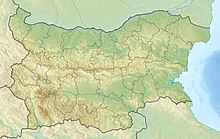Midžor
| Midžor | |
|---|---|
| Midžor Миџор (in Serbian) • Midzhur Миджур (in Bulgarian) | |
 Picture taken from the Serbian side | |
| Highest point | |
| Elevation | 2,169 m (7,116 ft) |
| Prominence | 1,478 m (4,849 ft) |
| Coordinates | 43°23′38″N 22°40′54″E / 43.39389°N 22.68167°ECoordinates: 43°23′38″N 22°40′54″E / 43.39389°N 22.68167°E |
| Naming | |
| Language of name | Bulgarian, Serbian |
| Geography | |
 Midžor Location of Midžor on the border between Bulgaria and Serbia | |
| Location | Bulgaria, Serbia |
| Parent range | Balkan Mountains |
Midžor (Serbian Cyrillic: Миџор, pronounced [mîdʒɔr]) or Midzhur (Bulgarian: Миджур, pronounced [miˈd͡ʒur]) is a peak in the Balkan Mountains, situated on the border between Bulgaria and Serbia. At 2,169 metres (7,116 ft), it is the highest peak of the Western Balkan Mountains, as well as the highest of Serbia outside Kosovo.[note 1] Midžor is the 12th highest peak in the Balkan Mountains.
Bulgaria[]
In Bulgaria, the peak is called Midzhur.
Since the early 1990s, it has been accessible to tourists from both sides; previously, access was forbidden due to the peak being in the border area. Due to those restrictions, the nature around the peak has been preserved untouched. On the Bulgarian side, the peak is reachable from the villages of Chuprene and Gorni Lom in Vidin Province.
Chuprene[]
From Chuprene there are two possibilities for climbing. There is a 17 km dirt road following the river Chprenska to the Gorski Ray refuge (1,450 m) or a 9 km foot track following the river Manastirska.
From the refuge there is a marked track which passes through the and leads to the main summit on a saddle between the peaks Replyanska Tsarkva (1,969 m) and Ostra Chuka (1967 m). To the south east through the peaks Ostra Chuka and Oba (2,033 m) the track reaches a saddle from where the Lom River and the Timok flow out at border stone 336. From there the peak can be climbed from the north-western slope.
Gorni Lom[]
At 7 km from the village of Gorni Lom is located the Gorni Lom refuge (840 m). There is also another refuge upstream called Mudzhur. There are steep tracks from there leading to the saddle between Oba and the peak at border stone 336 from where both tracks from the two villages merge.
Economy[]
The source of the Lom River is at the foot of the peak. A cascade of small hydroelectric power plants is in operation on the river near the peak and four more are under construction.[1] Chuprene biosphere reserve which is under the protection of UNESCO is situated to the west of the peak. It is one of the last sanctuaries in Bulgaria where the Capercaillie nests.
A special permission from a border police office (such as the ones in Sofia, Dragoman, Chiprovtsi, etc.) is required in order to ascend to the peak.
Serbia[]
In Serbia the peak is known as Midžor.
The extreme peak of the western mountain is north of the village of Topli Dol, located in the centre of Serbian Stara Planina, between (1936 m) on the SE side and (1758 m) on the SW side. The massif of the Midžor peak is substantial. Its western, eastern, and southern slopes are grassy and not so steep, while its northern side is rocky and very steep. This side is also the most attractive and very popular among rock climbers.
It is the highest peak in Serbia outside of Kosovo, and the 24th highest in the whole of Serbia if Kosovo is included.[note 2]
There is a hotel called "Babin Zub" on the slopes. There are no fees or permits needed to enter the Serbian Stara Planina.[2]
Gallery[]

Peak

Trail to the summit

Border stone

Sky and water

Clouds
See also[]
- Midzhur Peak in Antarctica, named after Midzhur mountain
Footnotes[]
- Notes
- ^ The highest peak of Serbia is officially Velika Rudoka in the Šar mountain range at 2,658 metres (8,720 ft), but it is located in Kosovo. If Kosovo is not included, then Midžor is the highest peak of Serbia.
Kosovo is the subject of a territorial dispute between the Republic of Kosovo and the Republic of Serbia. The Republic of Kosovo unilaterally declared independence on 17 February 2008. Serbia continues to claim it as a part of its own sovereign territory. The two governments began to normalise relations in 2013, as part of the 2013 Brussels Agreement. Kosovo is currently recognised as an independent state by 97 out of the 193 United Nations member states. In total, 112 UN member states have recognised Kosovo at some point, of which 15 states later withdrew their recognition. - ^ See: List of mountains in Serbia#Peaks over 2000 meters
- References
External links[]
- Midžor on Summit post
- The Bulgarian side of Midžor
- Peakbagger link
- Video of a hike to the top of Midžor from The Armchair Mountaineer
| Wikimedia Commons has media related to Midžor. |
- Balkan mountains
- Bulgaria–Serbia border
- International mountains of Europe
- Landforms of Vidin Province
- Two-thousanders of Bulgaria
- Two-thousanders of Serbia
- Highest points of countries






